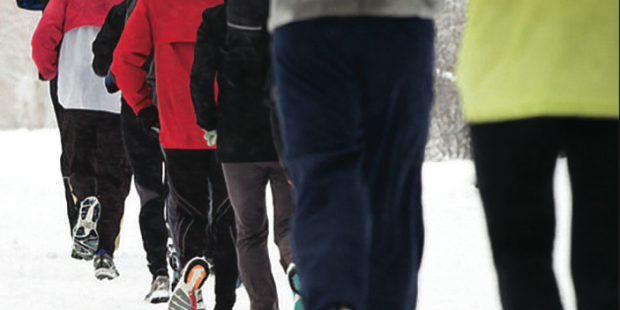Hibernation Elimination | Six Tips to Keep Your Training Going This Winter
 If fall is paradise for runners and bikers with its clear air and spectacular views, winter often feels like a form of penance. Maintaining an outdoor workout schedule through limited light and frigid conditions takes additional planning and, sometimes, steely resolve. Once out there, though, it’s rarely as punishing as anticipated.
If fall is paradise for runners and bikers with its clear air and spectacular views, winter often feels like a form of penance. Maintaining an outdoor workout schedule through limited light and frigid conditions takes additional planning and, sometimes, steely resolve. Once out there, though, it’s rarely as punishing as anticipated.
Vermont Sports wants you to keep going through the winter weather. All you have to do is minimize the risks and eliminate the excuses by following a few simple rules.
1. Get a grip.
Stay upright on ice and snow by swapping out footwear and tires for those with treads. Studded tires are available for bicycle commuters, as well as those that like off-road adventures, said Bob Hill, manager of Claremont Cycle Depot. Or try out a fat bike, the monster truck of bicycles with wide rims and extra-large tires that float on snow.
Runners can check out Icebug, a Swedish shoe company that offers running shoes with a studded sole. Icebug studs grip on slippery surfaces, but flex into the sole on solid surfaces to accommodate a variety of terrain. The more common Yaktrax, which stretch over the bottom of the shoe and around the toe and heel, give running sneakers the feel and traction (and sound) of a pair of cleats. April Farnham, an avid runner and personal trainer from Plainfield, solved the problem by screwing quarter-inch sheet metal screws into the bottom of her running shoes. Total cost: $2.40.
“You can’t feel them at all,” she said. “They don’t allow water into the shoe and the whole process takes 10 minutes.”
2. Layer it on.
Underhill’s Murray Banks, a four-time national champion triathlete and masters world champion cross-country skier, has a saying he sometimes repeats in his role as a professional speaker: “For outdoor fitness in Vermont, there’s no such thing as bad weather, only bad clothing.”
Good clothing includes a wicking, breathable base layer, a thin insulating middle layer, a wind-blocking, waterproof outer layer, and protection for the head and hands. Gore-Tex gloves help keep out the wind and the wet, but stretchy cotton gloves work in milder conditions.
Overdressing is a common mistake. Dress for 15 to 20 degrees warmer than the current temperature. A reflective vest or jacket is also necessary in winter’s dim light. For outings in the dark―darn short days― strap on a headlamp or carry a flashlight, and clip on as many blinking lights as possible.
3. Keep the water flowing.
Staying hydrated is just as critical in the winter as in the warmer months. Fluids are lost through sweat, as well as through every exhale. Switch to larger water bottles, if possible, as smaller ones may freeze, and try filing them with warm water instead of cold (the myth that warmer water freezes faster is untrue) or tucking them under a jacket.
4. Join the crowd.
Over the past two years, Farnham has seen five running groups spring up among the participants of her central Vermont boot camps. Knowing there’s someone waiting makes it harder to bail at the last minute, of course, but Farnham has found running with her group through all kinds of conditions has forged lasting friendships. “The bond you share with them is unbreakable,” Farnham said. “It feels like a secret club and the sense of accomplishment after each workout makes you actually look forward to the next [one].”
5. Put something on the schedule.
Signing up for winter races or early spring events will help break up the monotony. Pick a training program to follow and think about setting a more audacious goal than simply maintaining fitness. When the urge to slack off arises, remember the majority of the competition is training under the same conditions.
6. Have a backup plan.
Banks is a fan of cross-training with snowshoeing or free-skiing to build up core strength, which benefits both runners and bikers. Staving off frustration is a matter of “flexibility and adaptability,” he said. “Sometimes the weather will dictate what I’ll do.” As someone who travels frequently for work, Banks said he always has at least three or four other options, either outdoors or indoors, if it looks like his original plan is going to fall through. “Many times if it’s rainy, windy, and snowy, and I almost didn’t go, I’m always so glad I did,” he said, adding: “Fast-forward to the future, know ‘when I get done, I’ll be glad I did it.’”



